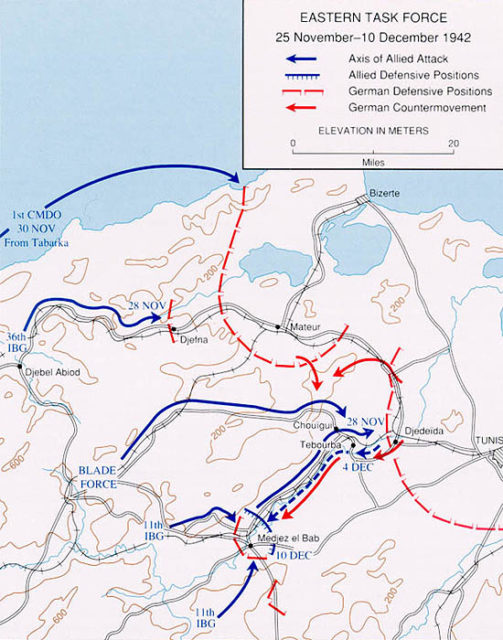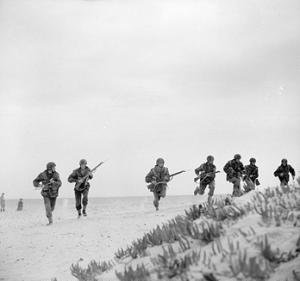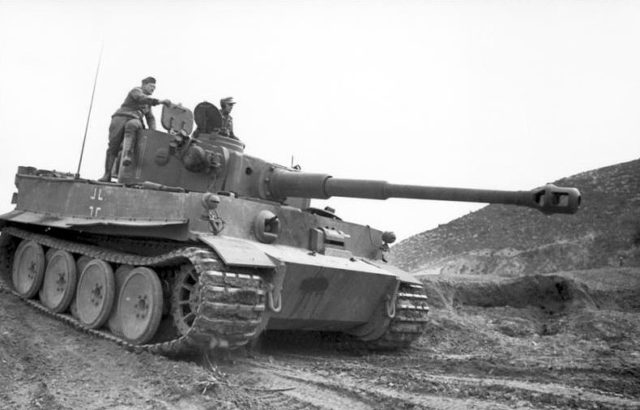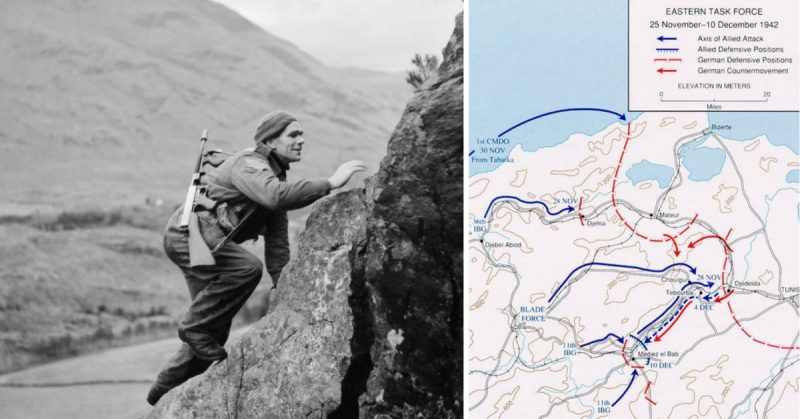In November 1942, British and American forces made their first decisive push to take control of Tunisia from the Axis armies. Having landed in the country earlier in the month, they gathered their resources and headed east, aiming to take the towns of Tunis and Bizerte.
The offensive faltered in the face of German and Italian resistance. As the Allies withdrew, a unit on a daring mission was left isolated behind enemy lines.
Fighting for the Hills
The road from the Allied lines to Bizerte was on the north flank of the front. It ran along a pass between two hills, one covered in green brush, the other topped with a smooth, gray area. The Allies referred to them as Green Hill and Bald Hill.
On November 28, a British force of infantry and Bren gun carriers advanced along the road. An offensive was opening up all along the line. The unit’s role was to clear the Axis forces out of the sector and advance on Bizerte.
As they approached the hills, the way seemed to be clear. There was no sign of the enemy. They advanced down the pass, between the high ground.
They were halfway down the pass when concealed heavy machine-guns opened fire. Ten of their twelve gun carriers were destroyed. 30 men were killed and 50 wounded.
The survivors rallied but were unable to reach the German positions. At nightfall they retreated, leaving behind 86 prisoners.

1st Commando Arrive
Meanwhile, another force was setting out. British 1st Commando, which included two platoons from the American 34th Infantry Division, boarded landing craft and sailed along the Mediterranean coast. Their job was to get behind the Axis lines, cut off enemy attempts to reinforce the pass, and harass Axis forces as they retreated.
Nobody opposed them when they landed on December 1. Two German planes buzzed by and shot at the landing craft as they departed, but 1st Commando had landed without casualties.
Across Country into Trouble
They headed south, marching eight miles to the road where they prepared to do their job.
Little did they know that events further west had already made their presence irrelevant. Following the disastrous ambush at Green and Bald Hills, the British commander had given up on reaching Bizerte. He had pulled back his forces.
For 1st Commando, it was the silence that gave it away. There was almost no traffic on the road. No German reinforcements were rushing to bolster their front. There was no one for 1st Commando to ambush. No battered forces were retreating towards Bizerte after being beaten by the Allies.
They had been sent into a dangerous position behind enemy lines. The assault had failed, and they were alone.

Ambush
Axis forces ambushed one of the American platoons, cutting it off from the rest of the force. The platoon leader, looking at the surrounding enemy and considering how far they were from help, decided it was useless. He ordered his men to surrender.
Sergeant Sessions refused. He was determined to fight his way clear. He invited any of the others who were willing to join him.
Together with two other men, Sessions fought his way out of the German trap. The three of them reached the other American platoon, joining up with their comrades.
Behind them, the rest of their unit had been captured.
Under Attack
The next day, 1st Commando saw significant German forces for the first time, as the remaining American platoon came under attack.
The Germans came from the south. It was a combined team of four tanks and supporting infantry. It was an intimidating sight for the Americans, who had no armored support.
To reach the Americans, the Germans had to cross a bridge.
The German infantry fanned out, taking cover along the sides of the road. The tanks advanced, halting before the bridge while they considered whether it could take their weight.
Screened by trees, three American infantrymen hurried down the side of the road. While another soldier sprayed the lead tank with fire from a Browning automatic, distracting the crew, they leaped up and attacked the turret with explosives.
It was no good. The tank, apparently undamaged, advanced slowly across the bridge, firing as it went. The other tanks and infantry followed.
Retreating along the riverbank, the Americans reached the shelter of nearby woods. There they realized they had left behind their radio, the only way of contacting the rest of the commando group.
Sergeant Taylor, who had led the attack on the tank, ran back, grabbed the radio in the face of the advancing Germans, and returned to the unit.

Out of Supplies
By now, it was becoming clear that 1st Commando’s mission was doomed. There were no advancing Allied forces to link up with. If they stayed where they were, the Germans would eventually overwhelm them.
There was also a more immediate problem. Given the nature of their mission and the expectation they would link up with other forces, they had brought few supplies. They had no blankets. Their food was limited. They were running low on ammunition and had run out of water purification tablets.
They risked drinking untreated water from streams and found it was fine, but that did not solve the other problems.
Heading West
Three days after landing, 1st Commando began their retreat. It was a harder walk than the one from the coast. This time they were crossing hills and mountains, passing through the front lines.
Five days after landing close to Bizerte, they reached Allied lines. They had lost 134 men in a bold mission that ultimately proved futile. It had been a harsh lesson in the challenges of war.
Source:
Orr Kelly (2002), Meeting the Fox: The Allied Invasion of Africa, from Operation Torch to Kasserine Pass to Victory in Tunisia
